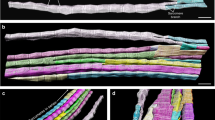Summary
Between the epimysium of the longitudinal muscle and the posterior aspect of the branchial cartilage ofSabella penicillum, an intermediate layer containing small muscle cells and fibroblasts embedded in an extracellular fibrous material are found. The small muscle cells contain 30 to 140 nm thick filaments with transverse striations at about 14.5 nm intervals, and are supposed to be paramyosin muscles. Their lenght were only a few μm and it could not be determined whether they were single sarcomere “striated” muscles, or true smooth muscles. Both the epimysium and the cartilage had numerous extensions that interdigitated with the muscle cells. Hemidesmosome-like specializations of the muscle cell membrane and its adjoining cytoplasm were characteristic features of the interdigitations. The arrangement with the short muscle cells makes it possible both to move the branchial crown, and to attach it for sustained periods.
Similar content being viewed by others
References
Auber, J., 1963: Ultrastructure de la jonction myo-épidermique chez les diptères. J. Microscopie2, 325–336.
Bonucci, E., M. Cuicchio, andL. C. Dearden, 1974: Investigations of ageing in costal and tracheal cartilage of rats. Z. Zellforsch. mikrosk. Anat.147, 505–527.
Bouligand, Y., 1962: Les ultrastructures du muscle strié et de ses attaches au squelettes chez les cyclops (Crustacés, Copépodes). J. Microscopie1, 377–394.
Caveney, S., 1969: Muscle attachment related to cuticle architecture inApterygota. J. Cell Sci.4, 541–559.
Claparède, E., 1873: Recherches sur la structure des Annelides sedentaires, pp. 1–199. Geneve: H. Georg.
Cohen, C., A. G. Szent-Gyørgyi, andJ. Kendrick-Jones, 1971: Paramyosin and the filaments of molluscan “catch” muscle. I. Paramyosin: structure and assembly. J. mol. Biol.56, 223–237.
Eakin, R. M., andJ. L. Brandenburger, 1974: Ultrastructural features of a Gordian worm (Nematomorpha). J. Ultrastruct. Res.46, 351–374.
Flood, P. R., D. M. Guthrie, andJ. R. Banks, 1969: Paramyosin muscle in the notochord of amphioxus. Nature (Lond.)222, 87–88.
Heumann, H.-G., undE. Zebe, 1968: Über die Funktionsweise glatter Muskelfasern. Elektronenmikroskopische Untersuchungen am Byssusretraktor (ABRM) vonMytilus edulis. Z. Zellforsch, mikrosk. Anat.85, 534–551.
Hoyle, G., 1964: Muscle and neuromuscular physiology. In: Physiology of mollusca, I, pp. 313–351 (K. M. Wilbur andC. M. Yonge, eds.). New York: Academic Press.
Hunt, S., 1972: The fine structure of the smooth muscle in the hypobranchial gland of the gastropodBuccinum undatum L. Tissue Cell4, 479–492.
Knapp, M. F., andP. J. Mill, 1971: The contractile mechanism in obliquely striated body wall muscles of the earthworm,Lumbricus terrestris. J. Cell Sci.8, 413–425.
Koulish, S., 1973: Microtubules and muscle attachments in the integument of theBalanidae. J. Morph.140, 1–14.
Kryvi, H., 1971: The structure of the longitudinal muscles ofSabella penicillum (Annelida, Polychaeta), with a note on the contraction properties. Norw. J. Zool.19, 149–167.
, 1973: On the presence of sarcoplasmic reticulum in obliquely striated muscles fromSabella penicillum (Polychaeta). J. submicr. Cytol.5, 23–28.
Lai-Fook, J., 1967: The structure of developing muscle insertions in insects. J. Morph.123, 503–528.
Lowy, J., andJ. Hanson, 1962: Ultrastructure of invertebrate smooth muscles. Physiol. Rev.42, 34–47.
McKenna, O. C., andJ. Rosenbluth, 1973: Myoneural and intermuscular junctions in a molluscan smooth muscle. J. Ultrastruct. Res.42, 434–450.
Mill, P. J., andM. F. Knapp, 1970: The fine structure of obliquely striated body wall muscles in the earthworm,Lumbricus terrestris Linn. J. Cell Sci.7, 233–261.
Millonig, G., 1962: Further observations on a phosphate buffer for osmium solutions in fixation. V. Internat. Congress Electron Microscopy, II, 8.
Nicol, E. A. T., 1930: The feeding mechanism, formation of the tube and physiology of digestion inSabella pavonina. Trans. R. Soc. Edinb.56, III, 537–598.
Person, P., 1964: Cartilage in a marine polychaete,Eudistylia polymorpha. Biol. Bull. mar. biol. Lab. Woods Hole127, 357.
,J. W. Lash, andA. Fine, 1959: On the presence of myoglobin and cytochrome in the cartilaginous odontophore of the marine snail,Busycon. Biol. Bull. mar. biol. Lab. Woods Hole117, 504–510.
, andM. B. Mathews, 1967: Endoskeletal cartilage in a marine polychaete,Eudistylia polymorpha. Biol. Bull. mar. biol. Lab. Woods Hole132, 244–252.
, andD. E. Philpott, 1963: Invertebrate cartilage. Ann. Acad. Sci. (N.Y.)109, 113–126.
, 1969 a: The biology of cartilage, I. Invertebrate cartilages:Limulus gill cartilage. J. Morph.128, 57–94.
Person, P., andD. E. Philpott, 1969 b: The nature and significance of invertebrate cartilages. Biol. Rev.44, 1–16.
Reynolds, E. S., 1963: The use of lead citrate at high pH as an electron-opaque stain in electron microscopy. J. Cell Biol.17, 208–212.
Schlote, F.-W., 1968: Die dicken Myofilamente der glatten Muskelfasern vonHelix pomatia. Z. Zellforsch. mikrosk. Anat.92, 503–508.
Smith, D. S., U. Järlfors, andF. E. Russel, 1969: The fine structure of muscle attachments in a spider (Latrodectus mactans Facr.). Tissue Cell1, 673–687.
,J. del Castillo, andM. Anderson, 1973: Fine structure and innervation of an annelid muscle with the longest recorded sarcomere. Tissue Cell5, 281–302.
Sobieszek, A., 1973: The fine structure of the contractile apparatus of the anterior byssus retractor muscle inMytilus edulis. J. Ultrastruct. Res.43, 313–343.
Swanson, C. J., 1971: Occurrence of paramyosin among theNematomorpha. Nature, New Biol.232, 122–123.
Thomas, J. G., 1940:Pomatoceros, Sabella andAmphitrite, pp. 1–88. Liverpool: University Press.
Watson, M. L. W., 1958: Staining of tissue sections for electron microscopy with heavy metals. J. biophys. biochem. Cytol.4, 475–478.
Welsch, U., 1968: Über den Feinbau der Chorda dorsalis vonBranchiostoma lanceolatum. Z. Zellforsch. mikrosk. Anat.87, 68–81.
Author information
Authors and Affiliations
Additional information
Concentrate of a manuscript that was awarded the “Joachim Friele's Gold Medal”, at the University of Bergen, December 1974.
Rights and permissions
About this article
Cite this article
Kryvi, H. Paramyosin muscle cells interposed between the longitudinal muscles and the cartilaginous skeleton ofSabella penicillum (Annelida). Protoplasma 84, 257–272 (1975). https://doi.org/10.1007/BF01279356
Received:
Issue Date:
DOI: https://doi.org/10.1007/BF01279356




